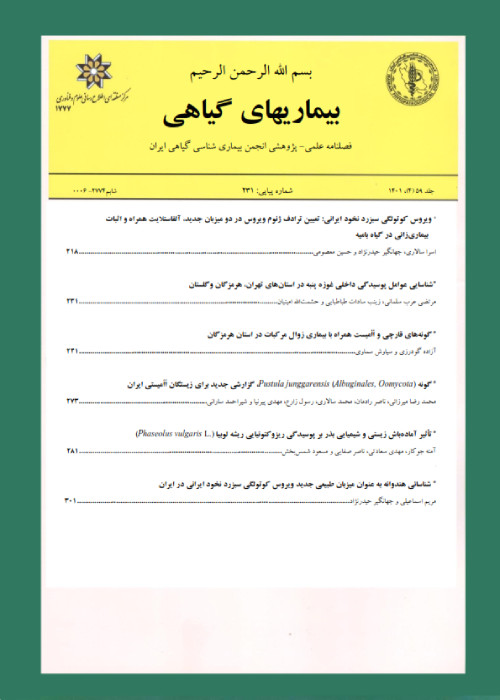OCCURENCE OF BIPOLARIS HAWAIIENSIS ASSOCIATED WITh RICE GRAIN IN IRAN
Abstract:
Rice plant is one of the most important and strategic agricultural product with having highest cultivation area after wheat in the world. Several factors including plant pathogenic fungi are causing agents of quantitative and qualitative losses in this plant. Brown spot is an important seed borne disease of rice that caused by different species of Bipolaris. Brown spots observed on infected grains in Shavor of Ahvaz at the end of crop season in 2009. Infected samples were transferred to laboratory and were cut parts between infected and healthy tissue. These parts were washed under water flow for 20 minutes. Seeds before putting into Petri dishes containing wet filter paper, were disinfected with sodium hypochloride 20% (1% active chlorine) for about 1 minutes and more was washed with sterile distilled water thrice and dried with sterile filter paper. Petri dishess were incubated under temperature of 22-25˚C. After 17 days, fungal clony formed around cultivated seed part was purified through single spore method. Colony diameter under darkness and optimum temperature was reached about 4 cm on PDA medium. Center and margin of colony was gray and dark brown, respectively. For sporulation, subcultures of colony were transfered on TWA+Wheat straw medium under optimum temperature and alternative light (12 hours darkness and 12 hours lighting). After ten days, conidia were formed on medium and wheat straw abundantly. Conidia were light to dark brown, smooth, often cylindrical, with 3-6 and often 5 pseudoseptum. Length and width of conidia were 8.75-37µm and 5-10µm, respectively. Conidiophores were single, cylindrical, light to dark brown with maximum height 120 µm and width 2-7 µm. According to the morphological characteristics and based on Ellis (1976) and Sivanesan (1987), the isolate identified as B. hawaiiensis that did not isolated from rice in Iran, before. Thus this is first report of the fungus associated to rice. Pathogenicity test of this fungus was done in greenhouse. Spore a suspension of inoculums 5×104 conidia/ml was prepared. No symptom was showed on the leaves and thaus pathogenicity of this strain did not proved in greenhouse.
Language:
Persian
Published:
Iranian Journal of Plant Pathology, Volume:47 Issue: 4, 2012
Page:
465
magiran.com/p966812
دانلود و مطالعه متن این مقاله با یکی از روشهای زیر امکان پذیر است:
اشتراک شخصی
با عضویت و پرداخت آنلاین حق اشتراک یکساله به مبلغ 1,390,000ريال میتوانید 70 عنوان مطلب دانلود کنید!
اشتراک سازمانی
به کتابخانه دانشگاه یا محل کار خود پیشنهاد کنید تا اشتراک سازمانی این پایگاه را برای دسترسی نامحدود همه کاربران به متن مطالب تهیه نمایند!
توجه!
- حق عضویت دریافتی صرف حمایت از نشریات عضو و نگهداری، تکمیل و توسعه مگیران میشود.
- پرداخت حق اشتراک و دانلود مقالات اجازه بازنشر آن در سایر رسانههای چاپی و دیجیتال را به کاربر نمیدهد.
In order to view content subscription is required
Personal subscription
Subscribe magiran.com for 70 € euros via PayPal and download 70 articles during a year.
Organization subscription
Please contact us to subscribe your university or library for unlimited access!


